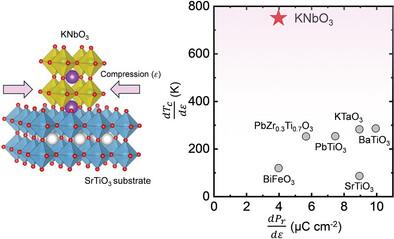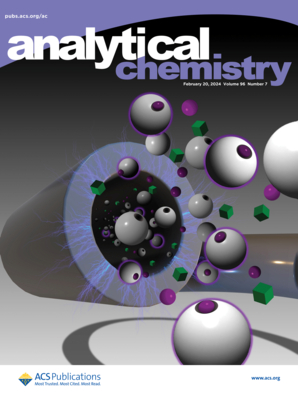KNbO3 薄膜铁电转换的巨大应变调谐
IF 6.7
1区 化学
Q1 CHEMISTRY, ANALYTICAL
引用次数: 0
摘要
铁电复合氧化物中极化(P)和应变(ɛ)之间的强耦合为显著调整其特性提供了独特的机会。这里展示了通过亚氧化物分子束外延生长的 KNbO3 外延薄膜铁电性的巨大应变调整。虽然块状 KNbO3 表现出三个铁电转换和居里温度(Tc)≈676 K,但根据相场建模预测,低至 -0.6% 的双轴应变可将其 Tc > 975 K(其在空气中的分解温度)推高到 Tc > 1325 K(其熔点)。此外,-1.5% 的应变可使单相在整个温度范围内保持稳定。与温度相关的二次谐波发生测量、同步辐射 X 射线倒易空间映射、铁电测量和透射电子显微镜相结合,揭示了从 10 K 到 975 K 的单一四方相,四方相的重正极化(Pr)增强了≈46%,其光学二次谐波发生系数比块体值增强了≈200%。在无铅系统中具有这些特性,但其性能却与铅基系统相当或更优,这使它成为从高温铁电存储器到低温量子计算等各种应用的理想候选材料。本文章由计算机程序翻译,如有差异,请以英文原文为准。

Colossal Strain Tuning of Ferroelectric Transitions in KNbO3 Thin Films
Strong coupling between polarization (P) and strain (ɛ) in ferroelectric complex oxides offers unique opportunities to dramatically tune their properties. Here colossal strain tuning of ferroelectricity in epitaxial KNbO3 thin films grown by sub-oxide molecular beam epitaxy is demonstrated. While bulk KNbO3 exhibits three ferroelectric transitions and a Curie temperature (Tc) of ≈676 K, phase-field modeling predicts that a biaxial strain of as little as −0.6% pushes its Tc > 975 K, its decomposition temperature in air, and for −1.4% strain, to Tc > 1325 K, its melting point. Furthermore, a strain of −1.5% can stabilize a single phase throughout the entire temperature range of its stability. A combination of temperature-dependent second harmonic generation measurements, synchrotron-based X-ray reciprocal space mapping, ferroelectric measurements, and transmission electron microscopy reveal a single tetragonal phase from 10 K to 975 K, an enhancement of ≈46% in the tetragonal phase remanent polarization (Pr), and a ≈200% enhancement in its optical second harmonic generation coefficients over bulk values. These properties in a lead-free system, but with properties comparable or superior to lead-based systems, make it an attractive candidate for applications ranging from high-temperature ferroelectric memory to cryogenic temperature quantum computing.
求助全文
通过发布文献求助,成功后即可免费获取论文全文。
去求助
来源期刊

Analytical Chemistry
化学-分析化学
CiteScore
12.10
自引率
12.20%
发文量
1949
审稿时长
1.4 months
期刊介绍:
Analytical Chemistry, a peer-reviewed research journal, focuses on disseminating new and original knowledge across all branches of analytical chemistry. Fundamental articles may explore general principles of chemical measurement science and need not directly address existing or potential analytical methodology. They can be entirely theoretical or report experimental results. Contributions may cover various phases of analytical operations, including sampling, bioanalysis, electrochemistry, mass spectrometry, microscale and nanoscale systems, environmental analysis, separations, spectroscopy, chemical reactions and selectivity, instrumentation, imaging, surface analysis, and data processing. Papers discussing known analytical methods should present a significant, original application of the method, a notable improvement, or results on an important analyte.
 求助内容:
求助内容: 应助结果提醒方式:
应助结果提醒方式:


